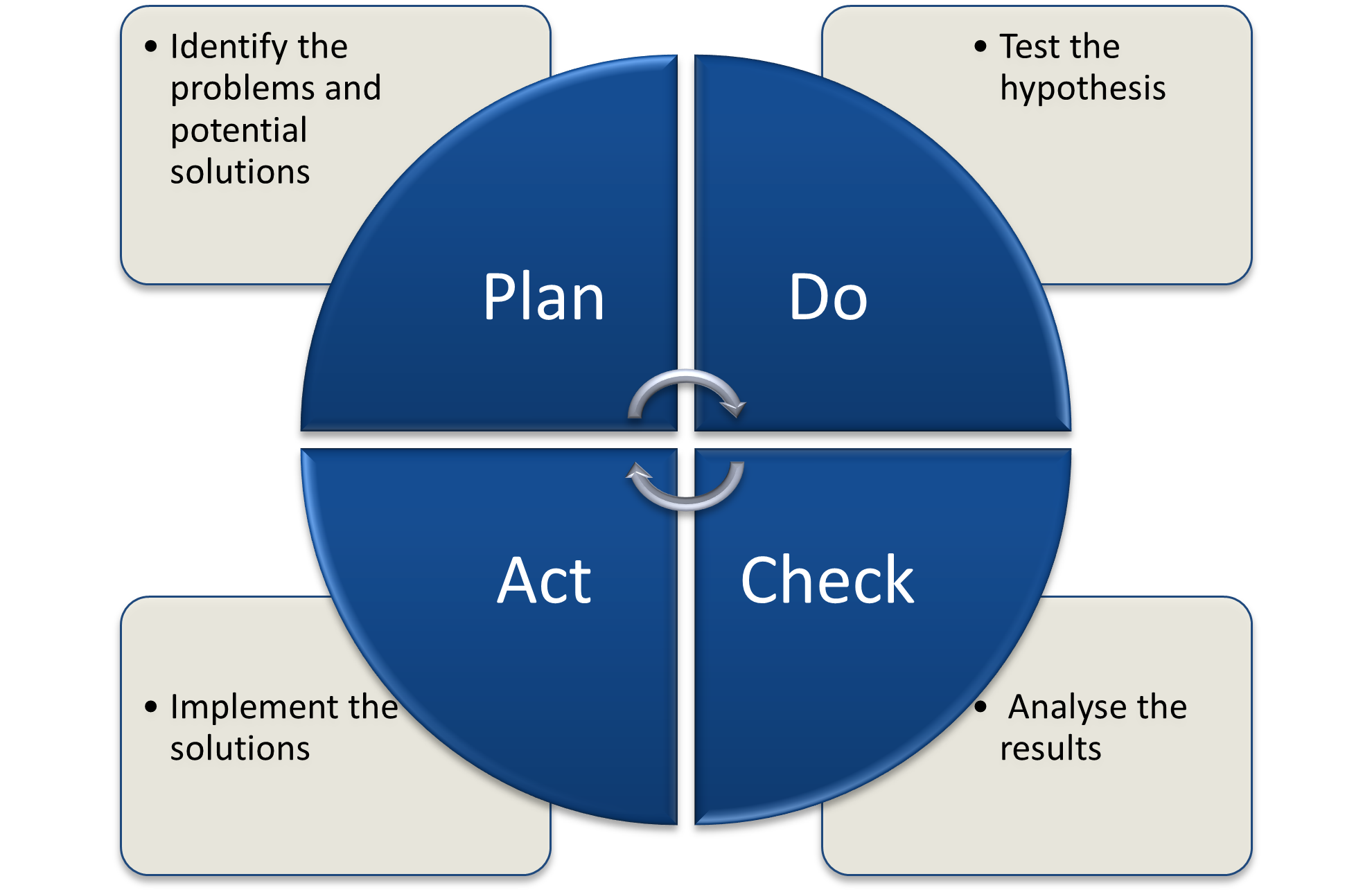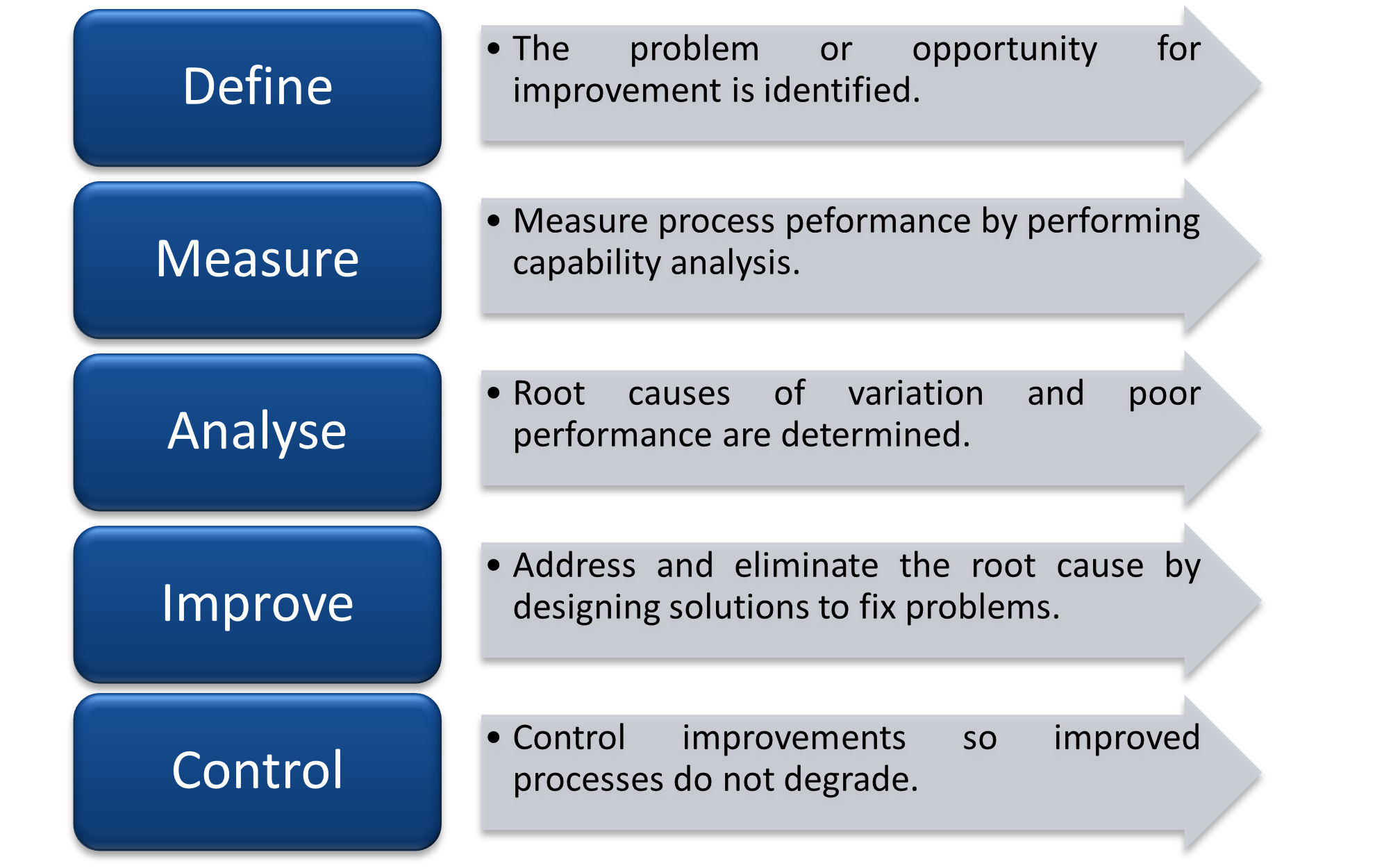Reviews of project outcomes are carried out repeatedly in order to continuously improve project quality processes. On a smaller scale, this is something that happens during and after each task or piece of work, where issues or shortfalls may be noted and improved on for the next task.
Continuous improvement refers to any activity, process, and task that you carry out through the course of the project, which entails the constant re-examining, re-inspecting, and improving processes. Ultimately, its goal is to achieve customer focus and enhanced quality of service.
In addition to the ongoing and incremental improvements, more formal reviews are scheduled as part of the project plan. These include:
 |
 |
 |
| Regular quality reviews as part of the validation process of each piece of work | Scheduled formal reviews and audits by the quality review team or auditors from outside the project team, usually at milestone points and the completion of each project phase as part of regular team meetings to inform continuous improvement | Regular or ad hoc meetings with the quality review team as part of continuous improvement and/or in response to specific issues |
Continuous improvement is essential in any project because not only does it ensure that outputs are meeting quality standards, but it also helps determine the effectiveness of the quality management activities.
As a member of a project team, it is important that you take part in the continuous improvement processes involved in your project because this will not only aid improvement of your current system or project but also help you acquire lessons which you can apply on future projects you will be part of.
Continuous improvement methodologies
There are several processes of performing continuous improvement to assure the quality of your project, including:
- PDCA cycle
- Six Sigma
- Lean management
- Lean six sigma
- DMAIC
- Total quality management
Plan-Do-Check-Act (PDCA) cycle
The PDCA cycle is a methodical approach to continuous improvement that is based on the scientific method and includes four steps, as illustrated in the diagram below:

- Plan – identify the problem (or opportunity) and come up with ideas (or hypotheses) for how to solve it.
- Do – trial or test the possible solutions on a small scale. This also involves the collection of data for analysis and measurement of progress as it happens.
- Check – analyse the results of the test and decide if the solution was effective.
- Act (or adjust) – implement the solution on a wider scale if it was effective; adjust if partially effective, or start again at step 1 to identify alternative solutions — then repeat the cycle.
Six Sigma
Six Sigma is a set of techniques and tools that focuses on improving processes. It aims to identify the causes of defects and remove them, while minimising variability in processes, thereby improving the quality of products and services. Six Sigma is focused on reducing process variation and enhancing process control.
The two basic options for implementing Six Sigma are as follows:
Implementing a Six Sigma program and initiative
This entails applying the Six Sigma statistical tools and methodologies to the people, processes, and tools
Creating a Six Sigma infrastructure
This focuses on setting up the environment, equipment, and other conditions that can support and influence the people in the teams and the processes
Lean
Lean is a set of management practices that are used to improve efficiency and effectiveness by reducing and eliminating non-value-adding activities and waste. Lean is focused on driving out waste and promoting work standardisation and flow.
A Lean System can be created through the following steps:
- Identify Value - The product/service must add value defined by the customer’s needs. Any other process or activity that does not bring value is regarded as waste.
- Map the Value Stream - Map the workflow of the company, including all actions and people involved in the process of delivering the end product to the customer.
- Create Flow - Make sure that the workflow of the team is maintained and remains smooth all throughout the processes undertaken.
- Establish Pull - Create a pull system by starting work only when there is actual demand or need for it. This does not only eliminate waste but also to optimise costs.
- Pursue Perfection - Ensure that all project team members are involved in the continuous improvement of the process.
Lean six sigma
Lean Six Sigma is a combination of Six Sigma and Lean. It focuses on customer satisfaction by valuing defect prevention over defect detection. Lean Six Sigma reduces variation, waste, and cycle time while also promoting the use of work standardisation and flow. This is a methodology that relies on a collaborative project team effort to improve performance by systematically removing waste while combining lean manufacturing/lean enterprise and Six Sigma to eliminate the eight kinds of waste (abbreviated as 'TIMWOODS'):
- Transportation – unnecessary movement of goods from one place to another
- Inventory – excess materials or products that are not used
- Motion – people moving around unnecessarily, e.g. between departments or processes
- Waiting – time wasted between processes or waiting on dependencies
- Overproduction – producing too much that is not needed
- Over-processing – producing higher quality work than is required
- Defects – waste caused by poor quality that needs to be modified or scrapped
- Skills – not using people’s talents effectively
Define, Measure, Analyse, Improve, Control (DMAIC) process
DMAIC is a five-phase, data-driven approach in continuous improvement of existing processes. This process is illustrated in the diagram below:

Total quality management
This is a comprehensive and structured approach to project quality management that uses a process of ongoing refinement in response to continuous feedback to improve the quality of products and services. All members of an organisation participate in improving the processes, products, services, and work culture.
The eight primary elements of Total Quality Management are:
- customer-focused
- total employee involvement
- process-centred
- integrated system
- strategic and systematic approach
- continual improvement
- fact-based decision making
- communications
Method for reviewing project outcomes
A Post-implementation review is conducted to evaluate the degree to which the project met the quality requirements and guidelines set at the initiating and planning stages of the project life cycle.
In conducting a post-implementation review, you may consider the following questions:
- Did the project fully accomplish the goal or purpose it was designed to address (e.g. solving a problem)?
- Can things be taken further, and deliver even bigger benefits?
- What lessons were learnt that could be applied to future projects?
Below are the activities involved in conducting a Post-Implementation Review.

Conduct gap analysis
The quality management plan and project charter must be reviewed in order to evaluate how the project matched the objectives set at the planning. To identify and analyse the gaps in the process and system, there is also a need to review the expected deliverables and assure that the deliverables meet the quality standards set out in the beginning.
The gaps in the process and system can further be identified by determining whether the project goals were achieved.
Conduct stakeholder satisfaction analysis
Stakeholders play a vital role in the project and thus must be kept engaged all throughout the course of the project. In this stage, the rate by which the stakeholders’ interests and needs were met will be determined. You should also identify the effects on the clients or end user and to identify any necessary intervention should the stakeholders not be satisfied.
Identify areas for further development
Determine the degree to which all expected benefits have been achieved. In this phase, you and your project team must identify the necessary intervention to achieve your desired results.
You must also consider if there are available opportunities for change or improvement in order to deliver more value and maximise the results. If other activities and resources can still yield additional benefits, these must also be considered and adapted.

Identify and report lessons learned, findings and recommendations
One of the most crucial parts of the post-implementation review is identifying the strengths and limitations of the project, and what contributed to those strengths and limitations. It is important to know the factors that led to both successes and shortfalls of the project in order to design future activities accordingly. Those that brought success can be replicated, and those that led to shortfalls can be eliminated accordingly. Recommendations as to which actions reap the most benefits and what lessons must be carried forward and adapted in future projects must also be discussed.
A report of the lessons learned must be communicated to everyone involved in the project.
Each problem that arises during a project, such as those recorded in the Issue Register, eventually gets resolved. Some problems are easily fixed based on the experience of the team members. However, some issues are new situations that need to be worked through. Once these problems have been resolved, the project team has learned something in the process.
The new lessons learned need to be documented. It is likely that the same, or similar, problems will come up again in the future. Having a documented solution will make working through the issues easier next time.
Additionally, the lessons learned needs to be communicated to people who are likely to come across it again. If you keep the lesson to yourself and someone else in the team comes across the same issue, they will be spending unnecessary time trying to work it out when you have the solution right in front of you.

There are various ways in reporting quality management issues, but the most common across many organisations is the Lessons Learned Register.
Lessons learned register
Throughout the life cycle of a project, it is good practice to document the lessons as they are learned. This may be in the form of an online database or a simple spreadsheet. This repository is usually called either a ‘lessons learned register’, or a ‘lessons learned log.’ Each individual team member has the responsibility to record the solutions and lessons they have been involved in. If insights are not documented as they happen, they can easily be forgotten.
The lessons learned register records both successes (where things went well) and solutions to issues (where things went wrong). Both of these have valuable lessons that can be used to inform future projects.
The level of information recorded in the Register will depend on the accepted organisational procedure and the convention for the project.
At a minimum, the Register should include the following items:
 |
 |
 |
 |
 |
| The date recorded | The project and process it relates to | A brief description of the situation in context | The solution, including detailed steps (or where to find them) for others to follow | Recommendations for future projects based on the lessons learned from the situation |
At the end of the project, the project team will usually be invited to add any other insights to the Lessons Learned Register. This usually happens after the final review and after the final project debrief/wrap up meeting.
The project manager will then include a summary of the lessons learned in the final project report and may include the actual Register as an appendix.
The individual project document (lessons learned Register) must be copied or transferred to the accumulated knowledge base repository for the organisation at the end of the project.
This is because the lessons learned are not only useful for the current project but add to the body of knowledge for future projects across the organisation.
Lessons Learned Register might vary across organisations. Below is a sample template of Lessons Learned Register.
|
Project Name: |
|||||
|
Category |
Description of Situation |
Impact |
Challenges |
Recommendations |
Proposed Activities |
|
|
|
|
|
|
|
|
|
|
|
|
|
|
|
|
|
|
|
|
|
|
|
|
|
|
|
|

